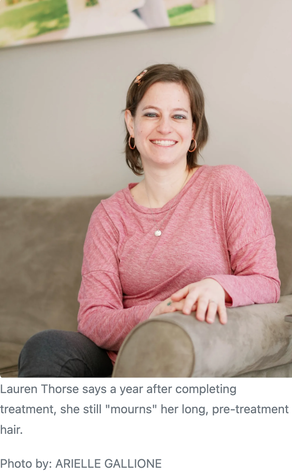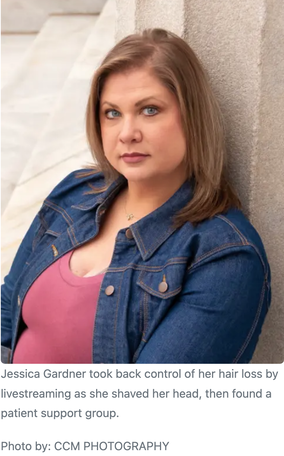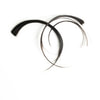|
Managing Chemotherapy-Induced Hair Loss Many survivors see significant hair changes during cancer treatment, leaving a difficult reminder when they look in the mirror.  Chemotherapy-induced alopecia, or hair loss, is a common side effect of many chemotherapy treatments for cancer. Chemotherapy works by targeting rapidly dividing cells, such as cancer cells. However, hair follicles also divide rapidly and are therefore affected by the treatment. As a result, hair loss can occur anywhere hair grows –– on the scalp, face and body. Not everyone who receives chemo will experience hair loss, but for those who do, it can be distressing. For many people, hair is an important aspect of self-expression and identity, and losing it can be emotionally difficult. As she recalls her experience with chemotherapy for breast cancer, Lauren Thorse remembers that when she was told she would need chemotherapy, “my first thought was that my hair is gonna go.” As someone who reports struggling for years with self-confidence, Thorse, of Naperville, Illinois, found the impending hair loss upsetting. Having always had long blond hair, seeing it fall out in clumps and finding it around the house led her to decide to shave it. With the support of her father, and her mother and sister via FaceTime, her husband shaved her hair off. After finally coming to terms with losing her hair, she then had to wrap her head around the fact that “it’s going to take years to get back to where it was.” Cancer survivor Jessica Gardner of Youngstown, Pennsylvania, also took matters into her own hands when she began losing her hair from chemotherapy. After being diagnosed with breast cancer while 33 weeks pregnant and undergoing a bilateral mastectomy not long after having a cesarean section, she felt that she wanted to have control over something — and that was her hair loss. While livestreaming the shaving of her head, she felt as if she was getting some of her power and control back. Once their hair was gone, both Thorse and Gardner felt frustrated over the lack of resources that were available to women their age, in their early 30s, with young children. They found that many of the resources were for older women and didn’t quite meet them where they were in life. Thorse recalls, “I felt like the wigs I was directed to were more for older women.”  Because Gardner found local support groups difficult to connect with, she created the group Cancer Is a Mother on Facebook. She found that this was a way to do something positive with her cancer diagnosis. “It was something I needed to do personally to feel better about cancer and where I was as a survivor.” Hair loss can be gradual or sudden, and it can begin within a few weeks of starting chemotherapy treatment. Some patients may experience thinning of the hair, whereas others may experience complete baldness. In some cases, hair may only thin or fall out in certain areas, creating patchy hair loss. This is most often temporary, and the hair will grow back once chemotherapy treatment is completed. However, in rare cases, some patients may experience long-term or permanent hair loss. The risk of either of those is generally low, but it can depend on the type and dose of chemotherapy used. Certain chemotherapies, such as taxanes, are associated with a higher risk of long-term or permanent hair loss. Now that a full year has gone by since completing chemotherapy, Thorse states that although her hair is growing, she doesn’t look like she used to. “Every now and then I do mourn for myself if I do see a picture. It’s been a year, but I still have a long way to go.” Chemotherapy isn’t the only cancer treatment that can affect hair. Hormone therapy for cancer treatment can target hormones that help cancer cells grow, such as estrogen and progesterone. It can be used to block the production of these hormones, or block the receptors that respond to them, or lower their levels. This changes the balance of hormones in the body and causes hair thinning. This also causes hair follicles to shrink, leading to thinner, weaker hair. Lisa Opalweski, of Fond du Lac, Wisconsin, has experienced hair loss multiple times during her cancer journey. Initially diagnosed with breast cancer in 2012, she notes, “Yes, I knew I was going to lose my hair; yes, I was going to run around bald for a while. I knew it was going to come back.” After being diagnosed with metastatic cancer in 2019, she has been treated with hormonal therapy and targeted therapy. “I used to have extremely thick, curly hair. Now I have baby thin hair.” Wigs and hairpieces can be used as a temporary solution for hair loss. Many cancer centers and support groups have resources for obtaining wigs or hairpieces at little or no cost. However, there are now ways to help manage hair loss through scalp cooling. Cooling the scalp during chemotherapy treatment decreases blood flow to the scalp and reduces the amount of chemotherapy drugs reaching the hair follicles. By reducing the amount of chemotherapy that reaches the hair follicles, patients experience less hair loss. According to the results of one study led by Dr. Julie Nangia, a breast oncologist and an assistant professor of medicine at the Lester and Sue Smith Breast Center and Dan L Duncan Comprehensive Cancer Center at Baylor College of Medicine in Houston, women receiving chemotherapy for early-stage breast cancer were enrolled in a study to evaluate the effectiveness of scalp cooling on hair loss. Of those who underwent scalp cooling, 50.5% had some preservation of their hair after four cycles of chemotherapy. In those who did not use scalp cooling, no one experienced hair preservation. There are currently a couple of ways to cool the scalp. One way is through the use of cold caps, which uses tight-fitting caps placed on the head to cool the scalp during chemo- therapy infusion. The caps are stored in a special freezer and must be changed throughout the infusion to keep the scalp at a sufficiently cold temperature. In order to successfully use the caps, a patient will need to have help to change the caps at the instructed intervals during treatment. Another method of scalp cooling is through a device that circulates coolant through the cap to keep the scalp at a consistently cool temperature. The hat is placed once at the beginning of treatment and the coolant will continue to keep the temperature consistent. According to Dr. Nangia, cooling the scalp starts 30 minutes before chemotherapy and the cap continues to be worn until 30 to 90 minutes after chemotherapy has been completed. It is also important to practice good hair care with scalp cooling therapy. This can include using a gentle shampoo, avoiding heat styling tools, and being gentle when combing or brushing the hair. Dr. Nangia notes that the biggest barrier to scalp cooling is the cost. If insurance does not cover the therapy, out-of-pocket costs can be over $2,000. She states that the National Comprehensive Cancer Network, which provides guidelines for cancer treatment and supportive care, has added scalp cooling to these guidelines as a method to be considered for those who may experience chemotherapy-induced alopecia. With this recommendation from the network, Dr. Nangia hopes that insurance companies will start covering the cost of this therapy so more patients can benefit. The rate of hair regrowth can vary for each patient, but typically hair starts to regrow within a few weeks to a few months after completing chemotherapy treatment. Regrowth may be slow at first, but it should become more rapid over time. It can take several months to a year for hair to fully regrow and regain its previous texture and color. In some cases, hair may not fully regrow or may regrow with a different texture or color. Chemo curls, also known as “chemo waves,” is a term used to describe the changes in hair texture that some patients experience after chemotherapy. The term refers to the curls, waves or kinks that can develop in the hair as it regrows. This can be caused by the chemotherapy treatment and the changes in the hair structure. It is not exclusive to scalp hair and can occur on hair all over the body. The new hair growth is usually soft and thin at first, and it may take several months for the hair to return to its pre-treatment thickness and texture. Some people may experience complete regrowth of their hair, whereas others may have patchy or thin hair growth. It also might take one to two years for hair to appear as it was before chemotherapy, and this can vary from person to person. Overall, hair growth after chemo is a gradual process, and it can take time for hair to fully recover. Many members of the health care team are involved during cancer treatment. However, one area that is often overlooked and underutilized during this time is dermatology. Dr. Adam Friedman, professor and chair of dermatology at George Washington University in Washington, D.C., knows what dermatologists can offer patients experiencing hair loss during cancer treatment, but they are not often a part of the cancer experience. He suggests prevention of hair loss through scalp cooling may offer the best results if someone is experi- encing complete hair loss, but there are other options for those with thinning hair that may be helpful. Applying topical minoxidil to the scalp can keep the hair in a constant state of growth. Friedman notes that it must be used consistently for best results and can be difficult to apply. He cautions against the use of supplements unless they are specifically approved by the health care team. Some supplements, such as biotin, can interfere with some blood tests, and may not be safe for some patients to use. He also notes that the off-label use of Latisse (bimatoprost) can be helpful for regrowth of eyelashes and eyebrows after chemotherapy. One of the most important things voiced by cancer survivors is that they want hair loss to be a topic that is brought up and discussed, and not glossed over, during visits. Megan Harman, FNP-C, with SSM Health in Lake St. Louis, understands this. She understands that hair loss can be a harsh reality the patient with cancer has to live with. It can be difficult for patients to fully prepare mentally and emotionally for hair loss until it happens. When talking with patients during this time, she often directs them toward various resources and allows them the time to voice their feelings about their situation. It is notable that much of the research about alopecia focuses on breast cancer survivors in comparison with other cancer survivors. One reason is that breast cancer is the most common cancer among women and the second most common cancer overall, so a large number of patients undergo chemotherapy treatment for breast cancer. Additionally, hair loss is a common and highly visible side effect of chemotherapy treatment, and it can have a significant impact on a person’s quality of life. Breast cancer survivors, especially women, tend to be more concerned about hair loss due to chemotherapy as hair loss affects their appearance and self-esteem. Another reason is that breast cancer research has traditionally been well funded, which has allowed for more research to be conducted on the effects of chemotherapy on hair loss in breast cancer survivors. This has resulted in a greater understanding of the mechanisms behind hair loss and the development of new hair loss prevention and treatment methods specifically tailored for patients with breast cancer. For more news on cancer updates, research and education, don’t forget to subscribe to CURE®’s newsletters here. from CureToday
Hair by Brian - The Beauty Blog
Comments are closed.
|
Hair by BrianMy name is Brian and I help people confidently take on the world. CategoriesAll Advice Announcement Awards Balayage Barbering Beach Waves Beauty News Book Now Brazilian Treatment Clients Cool Facts COVID 19 Health COVID 19 Update Curlies EGift Card Films Follically Challenged Gossip Grooming Hair Care Haircolor Haircut Hair Facts Hair History Hair Loss Hair Styling Hair Tips Hair Tools Health Health And Safety Healthy Hair Highlights Holidays Humor Mens Hair Men's Long Hair Newsletter Ombre Policies Procedures Press Release Previous Blog Privacy Policy Product Knowledge Product Reviews Promotions Read Your Labels Recommendations Reviews Scalp Health Science Services Smoothing Treatments Social Media Summer Hair Tips Textured Hair Thinning Hair Travel Tips Trending Wellness Womens Hair Archives
April 2025
|
|
Hey...
Your Mom Called! Book today! |
Sunday: 11am-5pm
Monday: 11am-6pm Tuesday: 10am - 6pm Wednesday: 10am - 6pm Thursday: By Appointment Friday: By Appointment Saturday: By Appointment |

 RSS Feed
RSS Feed